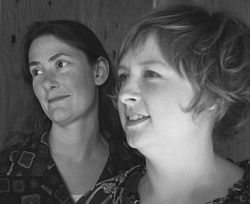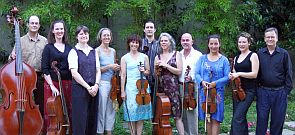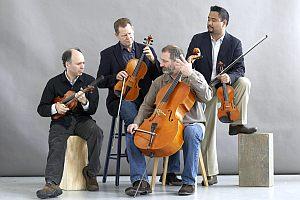The multitude of musicians and aficionados swarming, free of charge, through the San Francisco Conservatory last Sunday afternoon displayed how far the annual Chamber Music Day has outgrown the chamber it began in.

Pianist Hadley McCarroll had been there at the first event three years ago at the Berkeley Piano Club, which was “very, very intimate”, and very small. In ensuing years, the San Francisco Friends of Chamber Music (SFFCM), which hosts the Day, moved it across the Bay to Temple Emanu-El, then to Old First Church. Snacking in the Conservatory’s Harmony Café, several hours after her performance in the adjoining Recital Hall with cellist Monica Scott (who perform under the moniker of martha & monica), McCarroll explained the need for a larger venue this year. The Conservatory provided spaces in its Concert Hall and Osher Salon, as well as in the Recital Hall, for performances which began at noon and continued till almost 6:30 p.m.
“There are thirty-something groups, each with its own following,” McCarroll pointed out, “and people might say, ‘hey, there’s something two groups later, and I might like that’, so all those groups benefit. Then you have the opportunity to spread out, going to [three] different halls, so you might go hear more music instead of leaving the building for coffee. And the variety of the music! Validating that improvisation and jazz are actually legitimate forms of chamber music, or playing music from a different culture, that it’s as valid as a Beethoven string quartet. That’s fascinating to me, and great fun.”

The offerings moved back and forth in musical history, as well as across genre and geographical boundaries. Tim Nutt, a founder of Chisel Design and an advisor to the SFFCM website, looked down across the Osher Salon, where Lisa Mezzacappa was positioning her contrabass alongside her group Nightshade’s electric guitar, vibraphone, clarinets, and computer-controlled electronic effects, for a thoroughly modern session. “This is one of the first times the Conservatory has opened itself this way,” observed Nutt. “Now everything is completely different, and it’s a breath of fresh air. And the acoustics are amazing!” After the music had begun, the mewling of a restless infant seemed to fit right in.
McCarroll, after her snack, headed back to the Recital Hall, across the way from the Osher, to witness one of the “groups I’d never heard before” and was curious to experience. They were the Voices of Music, invoking spirited airs and dances from the 14th through 18th Centuries, on a large, exotic-looking archlute, oversized recorder, and percussion of Middle Eastern origin.
Live Is Better
Simon Feltman of Oakland had been there since noon for his very first Chamber Music Day, and had already seen seven different acts, including Earplay and sfSound, whose deployment of traditional instruments in a contemporary music context he was already familiar with. But what particularly impressed him at the Conservatory was the San Francisco Piano Trio’s selection from Beethoven. “I’d listened to him somewhat, but after seeing it live, it brought a whole new interest level for me,” attested Feltman. “It was the professionalism of the musicians, their physicality and the interplay, picking up on when to do changes, how they use bigger motions when they need to get each other’s attention. That’s pretty amazing, to see it in person.”

More Beethoven was delivered late in the afternoon by the Alexander String Quartet, to a spacious but jam-packed Concert Hall. Though a year over two centuries old, the “Serioso” quartet, Op. 95 sounded fresh and dramatically compelling. After the performance, three members of the Quartet repaired to the Atrium for one of several discussions between musicians and audience hosted by Salon 97, a community-based group “for people with an interest in arts and culture, but who find the formal nature of the concert hall intimidating."
Salon 97 curator Cariwyl Hebert introduced the chat with a biographical sketch of Beethoven, pointing out that “he was noted for his incredible improvisational skills, which were determined to be better than those of Mozart, even.” Alexander violist Paul Yarbrough extolled the “frenetic energy and stark contrasts” of the “Serioso,” as well as its “interpretive challenges.” This prompted questions from audience members about changes in the Alexander’s interpretations over the course of the group's nearly thirty years. “We’ve discovered that playing slow doesn’t mean being profound,” grinned violinist Frederick Lifsitz. “It might just be that we’re enjoying it more now.”
Yarbrough affirmed his ensemble’s enthusiasm about participating in the eclectic hustle and bustle of Chamber Music Day. “We wanted to be a part of this wonderful community,” he said. “Chamber music has always been kind of a grassroots art form, and for the most part, people kind of work in their own little space, and not often in a situation where they encounter one another. The whole spirit of this event is just a fantastic thing.”
From the stage of the Concert Hall a short while later, Renee Baldocchi of the Fine Arts Museums of San Francisco sighed rhetorically, “Wasn’t this an amazing day?”. Before introducing the afternoon’s final groups, the jazz-and-world-music-inflected Weber Iago Trio and Revolution Quartet, she announced that the event will be moving next year to the still-larger quarters of the De Young Museum in Golden Gate Park. Will Simon Feltman be returning, for an even greater afternoon of chamber-hopping? “Absolutely! It’s a great mix of stuff going on!”

